The model of raising free-range chickens for eggs is developing in many localities, initially bringing stable income to farmers. However, because of the specific characteristics of the free-range model, if you want chickens to lay eggs with high yield, uniform quality, and few diseases, people need to follow the right techniques of raising hens to lay eggs in the garden. The following article will guide you in detail and detail, please refer to it.
Preparing conditions for raising chickens that lay eggs in the garden
1. The barn
Location: It is necessary to choose a highland area, so it should be far from the source of domestic water wells, rivers, streams, canals to avoid water pollution. Depending on the number of chickens planned to raise, the appropriate land area is selected.
Choose direction: The most suitable direction for making chicken coop is Southeast. This direction has a cool natural wind in the summer, avoiding the northeast monsoon in the winter and negative effects when the weather turns bad. In case the terrain is not favorable to make the barn in the above direction, people can choose the South or the East direction.
Coop area: The area of the coop depends on the number of chickens. When raising free-range chickens in large quantities, it is necessary to divide plots and clear areas for convenience in management.
The floor of the chicken coop: The chicken coop floor can be cemented or tiled with red bricks, which is convenient for cleaning, disinfecting and cleaning up later, and at the same time, avoids mice and insects from digging to steal eggs and biting chickens. The ground needs to be solid, can add fillers (rice husk, dry sand or straw so that the floor of the barn is not damp and convenient in the cleaning process.
Roof of the barn: It is recommended to have a roof to insulate chickens, especially during the egg-laying stage. Because in the summer, chickens get heatstroke and die in mass if the temperature is too high. In addition to insulating corrugated iron roofs, people can grow creepers, make artificial rain rigs or grow cassava to reduce the temperature in the barn by up to 6 degrees, keeping the barn warm in the winter.
Exhaust fan design: to suck CO2 to the outside. The exhaust fan should be placed high.
Dimensions: Average height of chicken coop: 2.5 – 3m. The eaves protrude from 1-1.5m to avoid rain and sunlight. Walls should usually only be 30-40cm high, the entire upper part should use a crank net.
Breeding density: If you raise chickens to lay eggs in the garden, the density of caged chickens is reasonable from 4 to 4.5 chickens/m2.
2. Cage lighting
It is necessary to prepare enough light for chickens so that chickens can easily find nests, avoid pecking, and reduce stress. In particular, chickens will lay more when well-lit, uniform eggs.
Light needs of hens:
| Weeks of age | Thời gian chiếu sáng |
| 19 weeks old | 13 hours |
| 20 weeks old | 14 hours |
| 21 weeks old | 15 hours |
| Over 22 weeks old | 16 hours |
In addition, raising chickens to lay eggs in the garden, people should light more lights in the evening for about 2-3 hours. Adjust the lighting time to suit the weather conditions, if it is overcast, rainy and windy, the lighting time should be longer and vice versa.
3. Farming garden
The garden part must be 3 times larger than the cage for chickens to move freely, ensuring a density of 1m2/chicken. Rotating pulses outside the rearing garden must be surrounded by high wire mesh so that the chickens do not fly out or lose.
The garden floor is usually made of soil, flat.
When gardening, pay attention to the drainage system. Chickens should not be released on rainy days.
4. Chicks incubator
Chicken brooding cage with size 2m x 1m high enough to raise 100 chickens, cooped with cork, the cage floor is filled with filler or rice husk or wire mesh so that the chicks do not get cold.
Design 2 75W bulbs for 1 incubator to heat chicks.
Leave the chick brood cage empty for about 14 days before importing the chicks, besides, disinfect and clean the disease room.
Density of brooding chicks:
Week1: 100 fish/m2
Week 2: 50 fish/m2
Week 3: 25 fish/m
5. Feeder
Chicks from 1-3 days old, spread the food on the paper.
Chickens from 4-14 days old are fed a small trough
Chickens from 15 days or more are fed a long hanging trough.
In the hot season, chickens have a greater need to eat, so they must provide many feeders:
| Feeding troughs | Hot season | Winter |
| Trough length (cm/head) | 12 | 10 |
| Hanging trough (trough of 100 fish) | 6 | 5 |
6. Drinking trough
Drinking troughs can be interspersed with feeders or hung up.
When raising egg-laying chickens, it is necessary to pay attention to the arrangement of a reasonable drinking trough according to each season.
| Drinking trough needs | Hot season | Winter |
| Trough length (cm/head) | 6 | 5 |
| Hanging trough (trough of 100 fish) | 50 | 70 |
7. Sand bath, gravel trough for chickens
In the technique of raising chickens in the garden to lay eggs, people need to pay attention to making sand and gravel tanks for chickens. The size of the tank is about 2m long, 1m wide, 0.3m high with a density of 40 chickens.
8. Spread the beans for the chicken
Whether it’s an egg-laying hen or a broiler, it likes to sleep on its head. Therefore, in the barn, it is necessary to design a wooden or bamboo headboard (not made of smooth round trees).
The perch should be about 0.5m from the ground, each space should be 30-40cm apart.
9. Make a nest for chickens
Chickens often have the habit of laying in the morning and jumping up high. In the technique of raising chickens to lay eggs in the garden, people are forced to make nests because if they don’t, the chickens will lay eggs around, drop them and eat them. Laying nests are also a way to stimulate the fertility of chickens.
Make a nest to pay attention to:
The drive can be lined with straw or make use of baskets…
Design drives in rows, each drive usually has a diameter of about 20-25cm, about 25cm deep.
Place in an elevated position from 0.8 – 1m.
It is necessary to design a way up and down for chickens to walk.
Each side is 10 – 15cm apart so that the chickens can jump comfortably.
People need to fix the laying nest in one place because chickens have the habit of laying where they will lay there again. The nest must always be clean, cool, with direct light.
Choose a breed of chicken that lays eggs in the garden
1. Choose the breed of chicken that lays the wrong egg
Some breeds of chickens that we let go to the garden to get eggs effectively:
The North has a breed of Ri chicken that can lay an average of 80-100 eggs/year, the egg weight is 42-43g, the average adult hen weight is 1.3-1.8kg.
Dong Tao chicken breed (Khoai Chau, Hung Yen) is also an effective breed of chickens in the garden to get eggs with an average of 55-60 eggs a year, egg weight from 55-75g, adult hens weight from 2.5 – 3 kg.
In addition, there are also some chicken breeds that lay good eggs such as Ho Chicken, Mia Chicken, and Phu Luu Te Chicken that have the same egg production as Dong Tao chicken.
Some breeds of chickens that lay super eggs:
| Chicken breeds wrong eggs | Average egg laying yield (fruit/year) |
| Egyptian Chicken | 200 – 210 |
| Chicken Leghorn (Chicken Leghorn) | 160 – 220 |
| Rhode Island Red Chicken (USA) | 150 – 180 |
| New Hampshire Chicken | 180 |
| Chicken Nagoya | 200 |
| Chicken Isa Brown | 160 – 180 |
If you raise many different types of hens that lay different eggs, you should choose purebred breeds and divide them into different plots to avoid crossbreeding eggs between different breeds.
2. Criteria for selecting chicks
It is necessary to choose chicks with uniform growth in weight and body size.
Choose chicks with bright eyes, nimbleness, no dry feet, defecation, white feces, crooked belly, open navel, sagging wings.
3. Criteria for choosing laying hens
Chickens raised to laying stage need to choose hens over 1kg:
The comb is bright red and soft, and the appearance is beautiful.
The coat is smooth, soft and light in color.
Slim, agile body.
The ass is a bit saggy, the belly is big.
The anus is enlarged, the pelvis is wide, and the anal mucosa is enlarged.
The eyes are bright, the pupils are narrow but still bright.
The legs are small, the beak is short, the beak is straight, not bent downwards.
The hen lays wrong, the egg yield must be from 180 eggs.
If the other chickens in the flock have not yet reached the time of laying eggs, they must be kept separately so that the chickens continue to grow for good reproductive efficiency.
Taking care of chickens that lay eggs in the garden
1. Take care of chicks
Newly purchased chicks need to be placed in an incubator for special care. Chickens should be transported in the cool of the afternoon or early morning so that the chickens are not suffocated. Avoid stormy days, northeast monsoon.
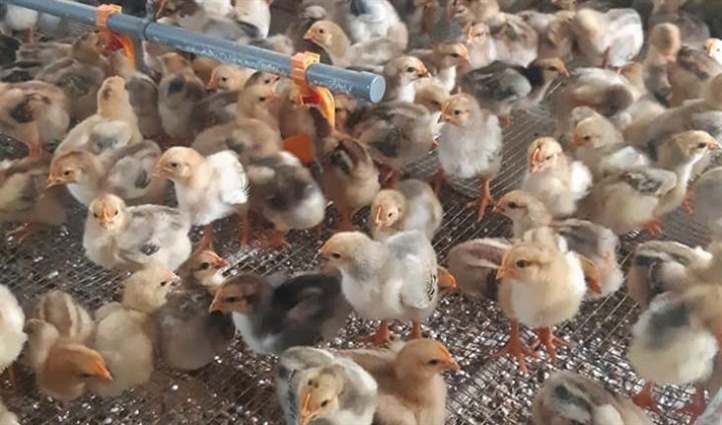
Taking care of chicks
Check the breeders, discard the unsatisfactory ones. Add vitamins or supplements to the water for chicks with a dosage of 2-3g/liter of water. It is necessary to ensure adequate water and feed (cooked broken rice or broken rice) for chicks. Divide the meal into several times, each feeding for about 2 hours to stimulate the flock to eat more. The amount of chicken feed will increase gradually, can add bran from agricultural by-products.
From day 7 must mix coccidiosis in the chick’s feed, use Rigecoccin 1 gr/10 kg feed (or use Sulfamid mixed 5% ratio).
The incubator environment must ensure ventilation, warmth, temperature and light suitable for the needs of the chicks, limiting harmful substances created by odors, especially ammonia from chicken manure.
Note:
Chickens should not be brooded right next to adult chickens (if any) because it is very easy to infect.
Should not be kept in captivity with a density exceeding the recommended level because the chicks will easily die, crushed to death.
Should not be sealed too tightly leading to anaerobic will cause chickens to suffocate.
When the weather changes, it is necessary to mix vitamins or Electrolyte into the water for chickens to drink.
From 15 days onwards, it is possible to raise chickens on a large barn area with a garden for chickens to grow quickly and lay eggs.
At 6-7 weeks, it is necessary to cut the beak for laying hens to reduce pecking (note only the horn part of the beak is cut).
Chicken feeders and drinkers must always be clean. It is necessary to change the water 2-3 times/day.
The water consumption of 1000 laying hens will depend heavily on the weather conditions outside:
Temperature (Celsius) Water Consumption (ml)
15 – 21 250 – 400
21 – 25 400 – 500
27 – 33 500 – 700
> 35 > 70
2. The hen laying eggs
So how long does it take for chickens to lay eggs? Usually, depending on the breed of chicken you choose, if raised in good conditions, it will give you a faster time to lay eggs. Especially if we apply the model of raising chickens in our garden, the egg production we get is extremely productive, the eggs are even, beautiful and clean.
When chickens reach the laying stage, they need to move to the area where the laying nest is located. Should move 3 days before because chickens are very stressed, and increase the amount of vitamins for hens.
Adjust the appropriate lighting in the broiler barn and the laying hen house.
Chickens should be transported as quickly as possible, in the early morning or late afternoon.
Density of farrowing cages: 3 – 3.5 heads/m2.
Need to meet enough food and drink needs for hens to lay eggs. Adjust the number of feeders and drinkers accordingly.
Chickens lay eggs often in the early morning, so focus on a lot of light so that the chickens are not stressed and stimulate the hens to lay a lot. Eggs can be harvested 4 times a day and stored in a cool room with a temperature of 13-18 degrees Celsius, humidity 75-80 degrees Celsius.
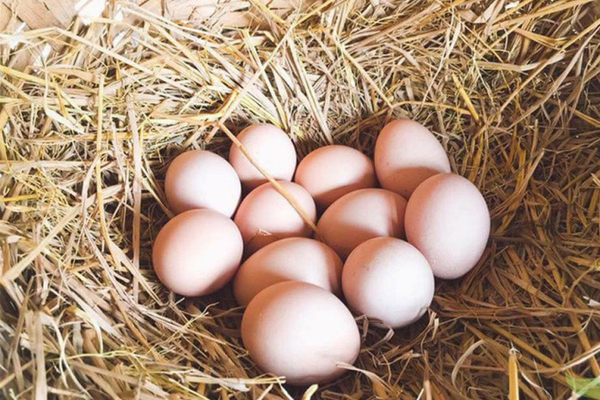
Chickens raised according to the free-range model for high egg production
The egg laying cycle of chickens:
Lay 2-3 eggs continuously, then take a break from laying for 1-2 days (laying every other day). The short length of this spawning cycle will depend on how long an egg takes to form. For egg-laying hens, the time is from 24 to 48 hours/fruit.
If eggs are formed within 24 hours, the laying cycle of hens will reach from 5 to 6 eggs, a record of 25 eggs / cycle.
The egg laying cycle lasts from 15-20 days and the chickens will stop laying and incubating.
You can adjust the egg laying cycle of chickens by adjusting the appropriate light for higher egg production.
People need to distinguish clearly, if a chicken lays eggs without a male, that egg will not be used as a breed because there is no “sperm” of the breeder. The embryo in the egg does not develop, so when incubated, the chicken egg will be damaged and cancerous. Therefore, if laying eggs for incubation, it is necessary to select more roosters. The method of pairing hens with an average density of 1 cock for 7-10 hens is appropriate.
When the hen is at the laying stage, it is necessary to take care of the cock as well, remove the ones that are discolored, weak, or perched on the roof of the nest or lying in the nest.
If chickens lay eggs for breeding, the embryo will start to develop from 24 degrees Celsius, the hatching rate of the eggs will decrease gradually and not exceed 7 days, so it should be incubated as soon as possible.
Note:
Chickens are laying normally but stop laying, the crest is brighter red or laying rough eggs even though they still eat normally, the chickens may have infectious bronchitis, people should get the H52 strain IB vaccine.
Chickens lay eggs that are not normal, different from the typical color, rough, uneven in size… is a syndrome of reduced laying in chickens. People should be vaccinated with EDS 76 oil emulsion, and given Embirio-Stimulan, 1-2 grams/liter of water within 3 weeks.
Chicken incubation
If chickens incubate eggs, the chickens will not lay, especially our chickens. So in the technique of raising chickens, we release the garden to get eggs or raise any chicken breed, people should proceed to wean the chickens.
After laying, the chicken will incubate for about 21 days, if we collect all the eggs, the chicken will still incubate, folk called ball incubation. Some of the methods of incubation are applied as follows:
Each time the chickens enter the incubator, they are dipped in the water twice a day, and the chickens are kept in a place with plenty of light, providing enough food and vitamins.
Put the hens in the cage, put them together with the roosters, and keep them in contact with the nest.
Tie the chicken’s wings so that the chicken can’t incubate the eggs.
Drive the hens out of the nest.
Give chickens aspirin 1-2 tablets/head/day or anlgin 150-200mg/bird/day to reduce the chicken’s body temperature.
Feed the chickens with a source of protein and green vegetables.
When the chickens have finished hatching, release the chickens back to the normal laying coop.
Feed for chickens that lay the wrong eggs
In order for hens to lay the wrong eggs with outstanding performance, farmers need to ensure to provide chickens with a crude protein ratio of 16 – 18% and 2,750 Kcal. At the same time, people must choose a food source with clear origin, quality assurance, and no pathogens.
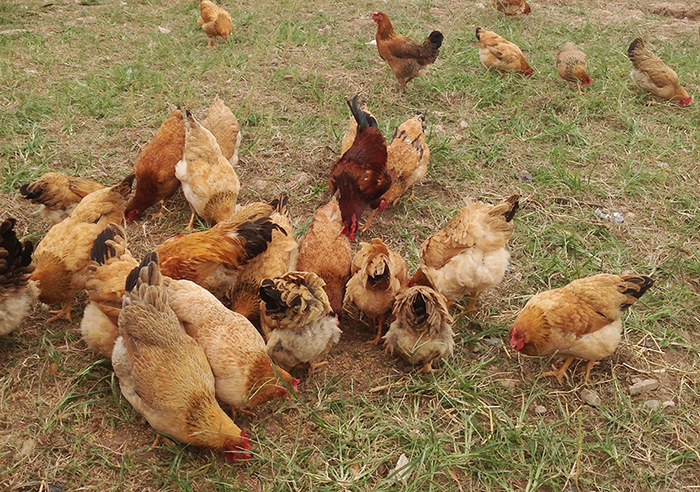
Diet determines the laying performance of hens
Food for hens that lay wrong eggs includes:
Food sources from agricultural by-products such as rice, paddy, maize, potatoes, muscle. Corn, potatoes should be broken into small pieces for easy absorption and good digestion by chickens.
Green vegetables, water hyacinth, water spinach to provide laying hens to eat regularly and continuously, especially when grazing. In particular, people can chop banana stems with banana slicers to feed chickens.
If you want chickens to lay many eggs, you must add 1.5-2% protein, bean residue or dried peanuts
Supplement calcium for laying hens with snail shell powder, shell powder, limestone powder crushed by snail mill and fed to chickens.
Note that a week should feed the chickens 1 meal of minced meat or fish or shrimp.
In addition, people can also add vitamins, ACID Pantothenic, ACID Folic, Biotin, Choline Chloride… in the daily diet of free-range laying hens.
The food source on farmers can also be ground into powder and mixed in the appropriate ratio, then pressed into bran pellets with the support of bran presses, which will help chickens eat more, digest well.
When hens are in the egg-laying cycle, they must increase the amount of feed to stimulate the hens to lay more eggs and give good egg production.
The amount of feed needed for laying hens is as follows:
| Weeks of age | grams/head/day |
| 1 – 6 | Eat freely |
| 7 – 10 | 45 – 55 |
| 11 – 16 | 55 – 65 |
| 17 – 20 | 70 – 80 |
| Laying hens | 115 – 125 |
Formula for mixing 1kg of powdered feed for laying hens:
| Ingredient | Ratio |
| Cornstarch | 45% |
| Rice bran | 20% |
| Meat powder | 8% |
| Fish meal | 7% |
| Oilcake | 10% |
| Coconut oil cake | 7% |
| Bone meal | 0,5% |
| Scallop powder | 2% |
| Powdered salt | 0,55% |
Hygiene of the hospital
– Clean the barn, the garden is clean, the pond is not stagnant, the water is stagnant in the garden.
– Cleaning and disinfecting livestock equipment, feeding troughs, drinking troughs, equipment for raising chickens that lay eggs in the garden.
– Observe and remove sick chickens, keep and care for them separately or destroy them so as not to spread to the whole flock.
Free-range chickens are very susceptible to coccidiosis, so it is necessary to prevent and treat the disease in time for the whole chicken flock.
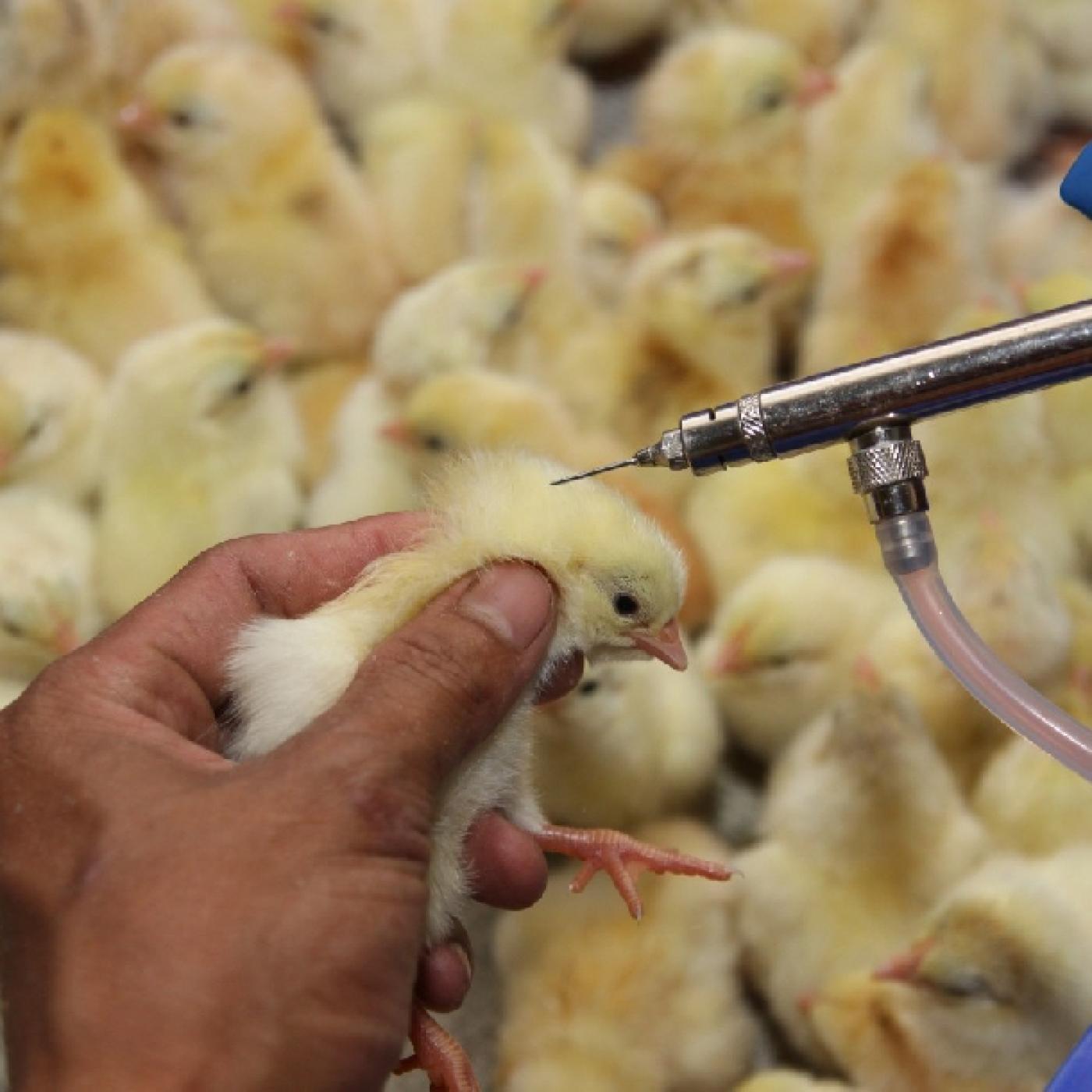
Vaccinate chickens on schedule
– Raising chickens in the garden to get eggs for high survival rate, fast growth, outstanding egg yield. When raising people, it is necessary to conduct disease prevention for chickens according to the correct cycle:
| Prevention | Date of age | Room way |
| 1st Gumboro | 5 – 7 | Small eyes, nose |
| Cholera 1st translation | 5 – 7 | Small eyes, nose |
| Vaccinate | 1 – 7 | Under the wing strain |
| Gumboro 2nd time | 20 – 21 | Small eyes, nose |
| 2nd cholera translation | 20 – 21 | Small eyes, nose |
| 3rd Gumboro | 33 – 35 | Small eyes, nose |
Common diseases in free-range laying hens
1. Coccidiosis
The rate of free-range chickens infected with coccidiosis ranges from 4 to 100%, on average from 30 to 50%, the percentage of chickens that die from 5 -15%.
The period from 2 to 8 weeks of age has the highest rate of disease.
There are 7 types of coccidiosis at different stages in the digestive tract of chickens: E. brunetti, E. tenella, E. necatrix, E. acervulina, E. maxima, E. mitis, E. praecox
Manifestations:
Chicken is moody, eat less
Diarrhea, bloody stools, sticky stools in the anus.
Chickens die 2-7 days after infection.
Treatment: Drugs to treat coccidiosis for chickens:
| Drug name | Water/food | Dosage, course |
| Amprolium | Water | 0.012% – 0.024%, 3-5 days 0.006% , 1-2 weeks |
| Chlotetracycline | Food | 0.22% ± 0.8% calcium, no more than 3 weeks |
| Oxytetracycline | Food | 0.022% ± 0.18 – 0.55% calcium, no more than 5 days |
| Sodium sulfachloropyrazine, monohydrate | Water | 0,03%,3 days |
| Sulfadimethoxin | Water | 0,05%, 6 days |
| Sulfamethazin (sulfadimidin) | Water | 0,1%, 2 days; 0,05%, 4 days |
| Toltrazuril | Water | 7 mg/kg body weight, 2 days |
2. “Wheezing” – Chronic Respiratory Disease (CRD)
Manifestations:
Conjunctivitis of the eye, lacrimation
Tracheal rales, runny nose, cough, reduced food consumption.
Facial sinus swelling
Arthritis, limping
In laying hens egg production decreased but remained at a low level
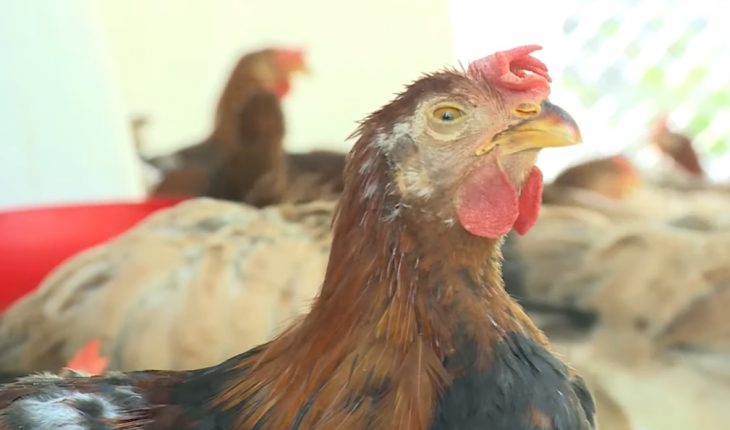
CRD disease in chickens
Treatment:
Using antibiotics to treat the disease: lincomycine, tylosin, josamycin, spiramycin, norfloxacin, enrofloxacin…
Use support with vitamins C, B – complex
Mix water with vitamins and electrolytes.
3. Cholera disease
Manifestations:
Chickens don’t eat, have dark feathers, their heads are down, they have difficulty breathing
Green liquid stools sometimes with blood
Purple crest, swollen eyes
Neck cuffs, turn around
Egg production is reduced, young eggs are many, strangely pale white.
How to prevent illness:
There is currently no specific treatment for cholera in chickens, because it is necessary to take measures to prevent the disease from spreading to the whole flock.
Use vaccines to prevent disease from 2 to 3 times.
Clean the barn.
Disinfect the cage with one of two products Antivirus-FMB or Pividine.
For chickens that lay eggs, antibiotics should only be used when chickens are sick. After 6 months of laying eggs, it is necessary to be vaccinated against cholera, coccidiosis, Gumboro for hens to lay eggs.
Above is information about technique of raising hens to lay eggs in the garden for high efficiency, outstanding productivity. Wish you success with this way of raising chickens in the garden to get eggs!




